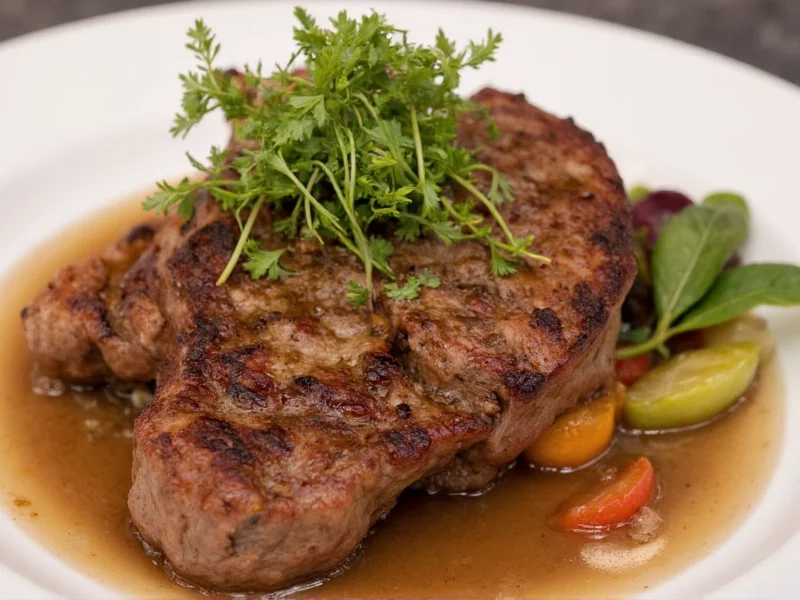The best herbs to cook with steak are rosemary, thyme, and garlic. These classic steak herbs complement beef's rich flavor without overpowering it. Rosemary adds a piney, earthy note perfect for grilled steaks, thyme offers subtle floral tones that enhance marbling, and garlic provides aromatic depth. For optimal results, use fresh rosemary sprigs when grilling, finely minced thyme in rubs, and raw garlic only in marinades (cooked garlic can turn bitter). These top steak seasoning herbs work across most cuts from filet mignon to ribeye, creating restaurant-quality results at home.
Understanding Herb-Steak Flavor Chemistry
When selecting herbs to cook with steak, understanding flavor chemistry creates better results than random experimentation. Beef contains glutamates that interact beautifully with certain herb compounds. Rosemary's camphor and cineole create a savory bridge between meat and smoke, while thyme's thymol enhances umami perception. This scientific approach to steak seasoning herbs explains why some pairings work while others clash.
Professional chefs consider three factors when choosing herbs for steak:
| Factor | Impact on Steak | Best Herb Choices |
|---|---|---|
| Fat content | Higher fat steaks need stronger herbs | Rosemary, sage, oregano |
| Cooking method | Grilling vs pan-searing affects herb selection | Grilling: whole sprigs; Pan: minced |
| Steak cut | Delicate cuts need subtler herbs | Filet: tarragon; Ribeye: rosemary |
Top Herbs for Steak and How to Use Them
Rosemary: The Steak Chef's Essential
Rosemary stands as the premier herb for steak preparation, particularly with ribeyes and New York strips. Its needle-like leaves contain essential oils that withstand high heat without burning. When grilling steak with herbs, place whole rosemary sprigs directly on coals for aromatic smoke infusion. For pan-seared steak, add finely chopped rosemary during the last two minutes of cooking to preserve volatile compounds.
Pro tip: Combine rosemary with black pepper and coarse salt for the ultimate steak seasoning blend. This classic herb combination creates complex flavor layers through the Maillard reaction.
Thyme: The Versatile Flavor Enhancer
Thyme's subtle lemon notes make it ideal for herb butter recipes for steak. Unlike many herbs, thyme maintains flavor integrity during extended cooking, perfect for reverse-seared steaks. French chefs often use bouquet garni containing thyme when braising tougher cuts, but for premium steaks, fresh thyme leaves sprinkled during resting time provide optimal flavor.
When creating steak herb rubs, thyme works exceptionally well with garlic powder and smoked paprika. The herb's earthy sweetness balances the char from grilled steak while enhancing natural beef flavors.
Garlic: The Aromatic Powerhouse
Though technically an allium, garlic functions as a foundational herb in steak preparation. Raw garlic can turn bitter when seared, so professional chefs use specific techniques:
- For grilling: Place whole garlic cloves in foil with herbs and tuck beside steak
- For pan-searing: Add smashed garlic cloves to butter basting mixture
- For marinades: Use minced garlic with acid to prevent burning
The best garlic for steak preparation comes from fresh bulbs rather than pre-minced varieties, which often contain preservatives that affect flavor.
Specialty Herbs for Gourmet Steak Experiences
Tarragon: The Filet Mignon Companion
Tarragon's anise-like flavor complements lean cuts like filet mignon. Create a compound butter with tarragon, shallots, and lemon zest for an elegant finishing touch. This French herb steak preparation technique works particularly well with medium-rare steaks where subtle flavors shine.
Oregano: The Bold Flavor Option
Often overlooked for steak, oregano brings Mediterranean flair to skirt and flank steaks. Use fresh oregano in chimichurri sauce or dried oregano in dry rubs for fajita-style preparations. The herb's pungency cuts through rich marbling while adding complexity.
Sage: The Umami Amplifier
Sage's earthy notes enhance the natural umami in well-marbled steaks. Lightly crush fresh sage leaves before adding to steak rubs to release essential oils. For an impressive presentation, wrap thick-cut ribeyes in sage leaves before searing—a technique known as involtini in Italian cuisine.
Practical Application: Herb Preparation Methods
Dry Rubs vs. Wet Marinades
The preparation method significantly impacts how herbs interact with steak:
- Dry rubs work best with coarse herbs like rosemary and thyme—apply 45 minutes before cooking
- Wet marinades suit delicate herbs like parsley—limit marinating time to 2 hours
- Compound butters carry herb flavors without overpowering—add during final cooking minutes
Fresh vs. Dried Herbs for Steak
Understanding herb forms prevents common mistakes:
- Fresh herbs contain 80-90% water, so use three times more than dried
- Dried herbs work better in dry rubs; fresh herbs excel in finishing applications
- Never substitute dried rosemary for fresh in high-heat applications (becomes bitter)
Avoiding Common Herb-Steak Mistakes
Even experienced home cooks make these herb-related steak errors:
- Adding delicate herbs too early in cooking (they burn)
- Using dried herbs in finishing applications (lacks brightness)
- Overpowering steak with too many herb varieties
- Not considering regional pairings (e.g., Mexican oregano with flank steak)
For best results, choose 1-2 primary herbs that complement your steak cut and cooking method. The perfect steak herb combination enhances rather than masks the natural beef flavor.
Creating Signature Steak Herb Combinations
Master these professional pairings for restaurant-quality results:
- Rosemary-Garlic Butter: Ideal for ribeyes—simmer fresh rosemary and garlic in butter
- Thyme-Peppercorn Crust: Perfect for filet mignon—combine with coarse salt
- Mediterranean Herb Blend: Best for flank steak—mix oregano, thyme, and rosemary
- Herbes de Provence Steak: Excellent for sirloin—use the classic French blend
Remember that less is often more when cooking steak with herbs. The goal is to enhance, not overwhelm, the natural beef flavor profile.











 浙公网安备
33010002000092号
浙公网安备
33010002000092号 浙B2-20120091-4
浙B2-20120091-4